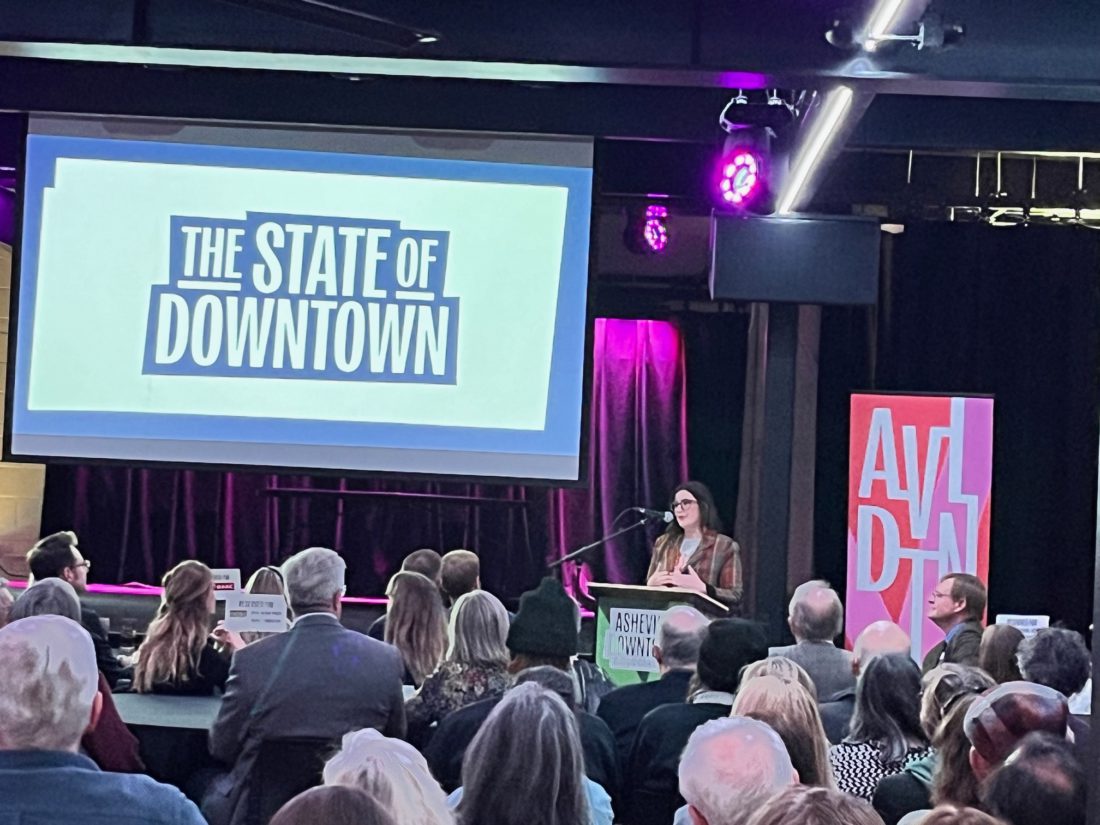Before beginning her remarks at the Asheville Downtown Association’s annual State of Downtown address March 19, Mayor Esther Manheimer commented that the occasion has not been fun the past few years.
The mayor was referring to downtown Asheville’s struggle with negative perceptions of high crime and rising homelessness, making the annual meeting of the downtown business advocacy group less than cheery occasions.
But this year’s address would be fun, Manheimer told the packed audience of business owners and politicians at the event space, Eulogy at Burial Beer Co. She welcomed new Asheville Police Department Chief Mike Lamb to uproarious audience applause, as well as new Asheville Fire Chief Michael Cayse, and recounted the City of Asheville’s progress in the previous year.
The mayor shared her enthusiasm about a potential business improvement district, or BID, in the city’s downtown. In 2012, City Council approved a BID for downtown Asheville, but it was never funded. “I’m very excited about the opportunity, again, to try for a BID here in Asheville,” Manheimer said. “We’ve hopefully set ourselves up for success.” (Asheville City Council saw a presentation about a BID at its March 26 meeting. Read more about the BID proposal at avl.mx/dhs.)
The mayor also mentioned as a highlight the 24-hour downtown restroom project. “We’re getting a Portland loo,” Manheimer said, referring to the 7-by-10-foot tall structure that will be located near Rankin Avenue parking garage. “These are virtually indestructible, because apparently people want to destroy bathrooms.”
Manheimer went on to call describe such aggression as a “tremendous expense and a tremendous challenge” for the city.
“I know the price tag has given everyone a little bit of sticker shock,” Manheimer said, referring to $650,000 allocated from American Rescue Act funds to the project. “Please know that a lot of that price tag is because we have to bring sewer and water to this site, so it’s more of an infrastructure [cost]. But these are, again, fairly indestructible and easy to clean and have lower costs in terms of managing them.”
Hayden Plemmons, Asheville Downtown Association executive director, also spoke approvingly of a BID at the State of Downtown address. While she praised the 60-day downtown safety initiative launched by the City of Asheville in May, she said a BID would be “a permanent solution” to addressing issues downtown. (Asheville’s BID, if approved, will have a term limit of 10 years, according to an informational website.)
Plemmons also shared results from the association’s Downtown Stakeholder Survey, conducted earlier this year. The survey primarily of downtown employees and visitors found safety was the top concern among respondents, followed by parking.
Holiday lights came up, too, a job that Plemmons announced may be taken up by the Asheville Downtown Association, which submitted a proposal to the city.
During his turn at the microphone, Buncombe County Board of Commissioners Chair Brownie Newman lauded the co-responder unit that pairs an officer from the Buncombe County Sheriff’s Office with a mental health professional from Buncombe County Emergency Medical Services’ community paramedics team to respond to certain acute calls. The program, Newman explains, is one piece of “attempting to divert individuals from the criminal justice system.”
Newman also spoke approvingly of proposals for low-barrier, high-access shelter being discussed by the City of Asheville and Buncombe County. A low-barrier shelter was a recommendation from the National Alliance to End Homelessness, which in 2023 presented a plan to halve homelessness in the area in two years.
Newman acknowledged that the community hasn’t reached “complete consensus” about supporting a low-barrier shelter but said he is convinced it’s needed. Newman noted that a location for a low-barrier shelter has not been confirmed.
Gerren Price, CEO and president of Washington, D.C.’s DowntownDC BID, delivered the headlining speech and outlined how BIDs operate in the nation’s capital. D.C. introduced BIDs in 1997 as the city was in the midst of a crack epidemic, Price explained. The DowntownDC BID originally paid for 100 hospitality ambassadors to provide a presence on the street in tourist areas; over time, the BID’s focus switched to addressing cleanliness and safety.
DowntownDC’s BID employs 85 ambassadors, who focus exclusively on safety, hospitality and maintenance across 1 square mile in its major tourist area between the White House and Union Station. Among other responsibilities, they aim to remove graffiti within 48 hours after it is reported.
“It’s all about getting expletive done, getting through the red tape, cutting through bureaucracy,” Price said. He praised the BID structure for being able to “amplify” the services already provided by a city and county, and ended on a positive note. With a BID, he said, “there’s so much possibility.”





FLASHBACK
To BID or not to BID: Government coercion no solution to downtown issues
August 21, 2012
https://mountainx.com/opinion/letters/082212to-bid-or-not-to-bid/
#avlnews #avlgov